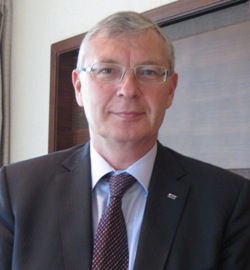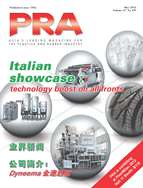 |
 |
In this Edition April 2012 |
LEAD FEATURE |
COMPANY NEWS |
MATERIALS NEWS |
MACHINERY NEWS |
EXHIBITION NEWS |
INJECTION MOULDING ASIA |
RUBBER JOURNAL ASIA |
PRA May 2012 Electronic Issue Now Available |
Lead Feature
Greening the automotive sector
 |
At the recent Chinaplas show, PRA interviewed Christof Krogmann, Vice-President for Lanxess's Semi-Crystalline Products business unit in Asia Pacific to share with us the latest solutions designed to meet the demands for green mobility and the company's plans in the region.
PRA: What are the company's sales projections for this year and how does Asia fare in this?
KROGMANN:We just concluded our first quarter of this year and it was a little weak due to the lengthy holiday period. We, however, expect business to warm up in the next quarter. The company posted sales worth EUR8.8 billion in 2011.
Asia plays a vital role, accounting for 23% of our business. By 2015, we hope to achieve EUR2.7 billion in profits. About 17% of the sales come from Lanxess's green mobility products and in China alone, high performance plastics is strong, accounting for about 15% market share.
PRA: How important is the Chinese market to Lanxess?
KROGMANN: China's automotive market is rapidly growing and it's expected to grow up to 8% this year. At the same time, the Chinese government is promoting sustainable growth for the economy by supporting energy conservation and high utilisation of resources. This is a great time for us to introduce solutions for green mobility.
Plus, Hong Kong, China, Taiwan and Macao are important market's for Lanxess's global growth strategy. This year, we're targeting more than EUR1 billion sales there. All of our 13 business units are represented at ten sites in these places, with roughly 900 employees in total.
PRA: Please give a brief on the application of high-tech plastics in the automotive industry.
KROGMANN: Today's green mobility trend demands for lighter and more fuel efficient cars and Lanxess is meeting this demand, particularly with the Durethan polyamides and Pocan polyesters.
A way to reduce car weight, without compromising cost effectiveness and performance, is with our polyamide composite sheet hybrid technology. This composite structure is an ideal alternative not only to metals but also to carbon fibre-reinforced thermosetting systems, both from an economic and performance point of view.
These solutions are made possible with Lanxess' tailored customer service, which we brand as HiAnt. We have in-depth capacity to develop products, applications and processes. This high value service covers virtual prototyping and incorporates the use of advanced testing equipment.
PRA:What are the trends driving green mobility?
KROGMANN: There are four factors that are driving the trend towards green mobility. Firstly, it is fuel efficiency, lighter cars need less fuel to run. Secondly, plastics are easier to mould than steel - this provides car manufacturers the design freedom to create new vehicles that were not imaginable some ten years ago; The third factor is that plastics are easy to replace and are non-corrosive thereby lessening environmental impact; And lastly, plastics help improve passenger safety. In addition to that, high-tech plastic materials can extend the service life of an end-product by three to seven times.
This is where Durethan and Pocan can play a key role. By replacing metal components, cars become lighter and thus contribute to fuel efficiency and reduced emissions. These materials enable carmakers and car parts suppliers to achieve considerable savings through easier assembly.
In a nutshell, building lighter cars is one of the most effective ways to save fuel and protect the environment. We've created the world's first brake pedals made of polyamide. Through the use of plastics, the pedal's weight has been reduced by 50%. Polyamide composite sheet technology can also cut airbag housing weight by more than 30%. Also, using green tyre technology can help realise fuel savings of up to 70%.
PRA: How is Lanxess responding to the trend towards turbocharged engines?
KROGMANN: We're responding to this trend with our polyamide technology. Because turbocharged engines run at higher temperatures, they need plastics that are more heat-resistant. Our pseudoplastic polyamide grades can withstand high temperatures suited to engine-air management systems. The heat stabilised Durethan AKV325 can be used to blow mould charge-air tubes.
PRA:At Lanxess, how long is the time-to-market of engineering plastics and what are the biggest R&D challenges?
KROGMANN: It takes Lanxess two to three years to develop products, with new innovation and technologies. These steps forward involve almost all vehicle components and naturally have an impact on performance, driving comfort and environmental safety.
We have a very strong development pipeline with major automotive OEMs and tier-one companies in the region.
Lanxess is already established in the Asian region through its flagship brands of high-tech plastics as these materials offer a lighter-weight plastic alternative to metals such as steel or aluminium.
Some of our biggest R&D challenges are to develop innovative technologies that power green mobility, including overcoming the boundaries of the material. For instance, as car engines become more compact and powerful, we're continually looking for resin grades that have higher resistance to heat.
PRA: How does the company keep up with the growing demand?
KROGMANN: Lanxess has just expanded its capacities for the high-tech plastics at its compounding plant in Wuxi, Jiangsu province to 60,000 tonnes/year. We also launched a new compounding facility with 20,000 tonnes/year in Jhagdia, India, to serve the booming market. In this facility, polymers are mixed and refined with additives or glass fibres to produce Durethan and Pocan as per customer's requirements.
Plus, we are building a new development centre in Hong Kong in the second half of 2012. This centre will significantly enhance our ability to meet the growing needs for green mobility. It will be equipped with computers and engineering facilities and it will focus on the company's high-tech plastics Durethan and Pocan. Furthermore, it will use high-end and comprehensive approaches that include prototyping and parts testing.


